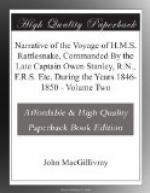Signs of cultivation.
The strip of forest behind the village is traversed in every direction by well beaten paths, chiefly leading to the back part of the island, where, on the slope of a hill in good soil, we found many patches of rude cultivation. The chief plant is a broad-leaved species of yam, trained upon tall poles kept in position by cross bamboos, forming a framework divided into little squares, each of which contains a plant. A species of Calladium with an esculent root is also much cultivated; it is planted in regular rows with the earth heaped up in ridges, as in a potato or turnip field at home. I noticed some small plots of ground prepared with more than usual care for the growth of what Giaom told me was a herb used as tobacco; the young plants were protected from the sun with pieces of matting.
Collection of human skulls.
Not far from the village, under the shade of an aged mimusops tree on the outskirts of the wood, we observed a cleared oval space where ten human skulls—of former members of the tribe, as we were informed—were arranged upon a plank raised on stones a foot or so from the ground. The skulls were mostly old and weather-worn, and some of them had pandanus seeds stuck in the orbits by way of eyes. In front was a large smooth stone painted red and black, and partially embedded in the earth, and beside it were some painted human leg and arm bones, shells and other ornaments. Behind, some thirty or forty skulls of turtle were arranged on the ground in several rows forming a triangle.
Curious screen.
In a beautiful opening among the trees behind the village we saw an extraordinary screen—named wows—the purpose of which, so far as we could understand, had some connection with the memory of the dead. It extended fifty-six feet in length, with a slight outward curvature, and measured five feet and a half in height. It was formed of a row of poles stuck in the ground, crossed in front by three horizontal strips of bamboo, and covered with cross latticework. The bars of the screen were daubed over with red paint, and hung with rows of spider-shells also painted red. Some poles projecting above the others two to four feet had painted jaws of the dugong and large conch shells (Fusus proboscidiferus) fixed to the top, and numerous other dugong bones and shells were scattered along the front. On the ground along the foot of the screen was a row of stones painted with black and red in imitation of grotesque faces, and to several of these the old man who acted as cicerone attached the names of persons who were dead. In some the painting was comparatively recent, and the stones appeared to have been placed there singly at different periods to commemorate the death of the heads of families of the tribe. We saw another of these curious funeral screens—like the first one it was situated in a little glade in the forest, but unlike it the front was covered or thatched with coconut leaves, and it had a small door-like opening in the centre.




